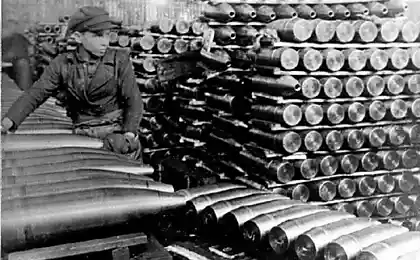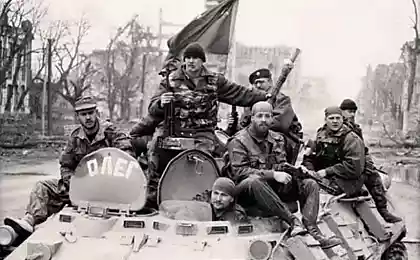2635
Automatic sorting of letters appeared in the USSR in the 60s.
Automatic sorting of letters appeared in the USSR in the 60s. Then it was put into operation about 180 letter-sorting machines and a population accustomed to write codes on envelopes. But with the beginning of the 90s, Russia moved to the European format of writing e-mail addresses to which the machines were not designed. In some regions, particularly in Samara, was written oebspechenie software to read addresses in the new format. But existing postal computers had already outdated (eg, as a carrier of information they used paper tape) and the collapse of the Soviet Union made it impossible to upgrade them, as the main producer of the machine is in Kharkiv. As a result, mail had to go back to manual sorting.
Over the past 20 years, the system of automatic sorting using postcodes in Russia virtually absent. Prior to the opening of the Moscow ASC mailings in CFD subjected manual sorting first in the district post offices, and then - in the regional and finally, in the sorting center in Moscow. Now in regional nodes mail will only be grouped into containers and then sent to Moscow to sort ASC.
The center carries out detailed sorting (up to the post offices) to 3 million mail items per day. Through the Moscow ASC will be about 25 percent of the country's postal exchange. Switching mail traffic on Moscow ASC will reduce delivery times correspondence. Inside the Moscow-mail will be delivered per day, excluding the day of admission. For cities and regional centers this standard is 2 days for small towns and rural areas - 3 days.
1. ASC - the largest center of its kind in Eastern Europe, with an area of 29 thousand sq. M. m., and employs about 900 people. Power ASC 3 million mail items per day.
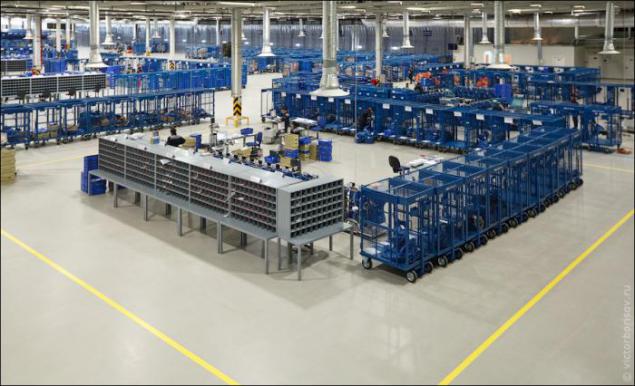
2. Correspondence within one region will first be directed to the center - as explained in the ASC, it is faster than to sort and check emails on the spot.
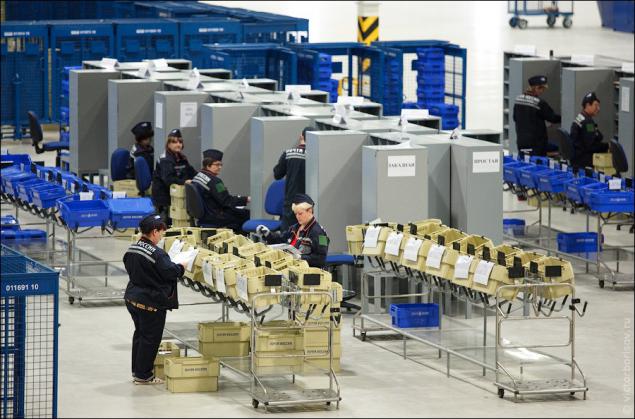
3. Parcel will be sorted to the area (this is due to the logistics of delivery), letters of large format (flat) - yet also to the area, but plan to purchase additional sorting machines to deliver this type of correspondence to the post office.

4. Paper correspondence falls first on litsovochno-stamping machines (CFC).

5. The machine for opening bags and dust extraction.

6. Then, with the help of mechanical devices are separated by analyzing standard (in size) letters and postcards from non-standard.
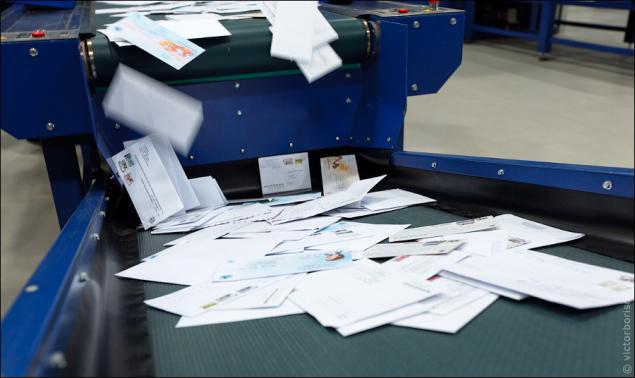
7. Poslee that letter automatically orients face in the same direction with the direction of the text in the address part.
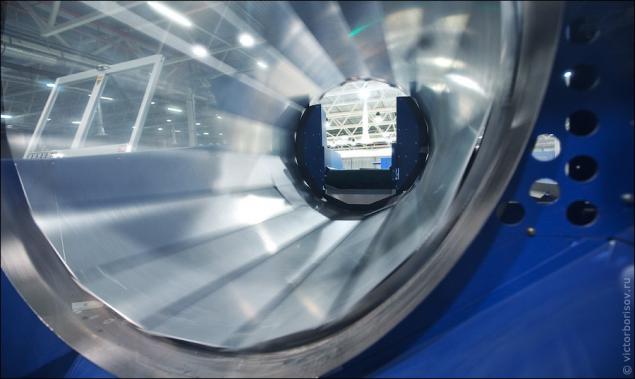
8. At the end of the machine causes the letters date stamp and wavy lines to repay marks (stamping).
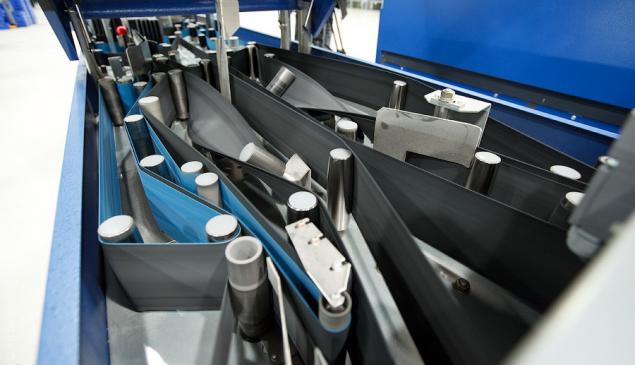
9. sorted by size letters are formed into containers and sent to the machine coding and sorting of letters (LCSM)

10. There are sorted standard letter size plain 220h110 114h162 mm mm.
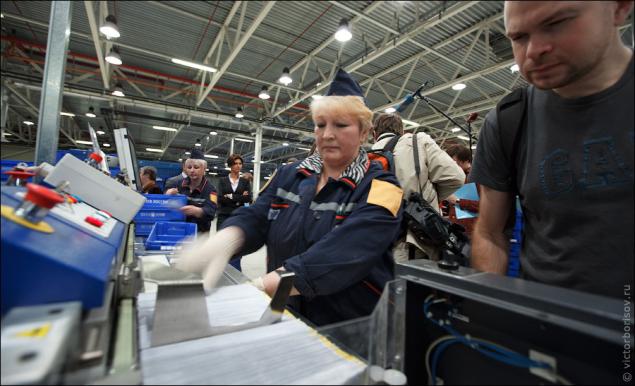
11. At the beginning of the coding machine converts alphanumeric address in conditional code that is printed on the letter.

12. Next, the coded information about the postal address of scanning devices for optical character reader.
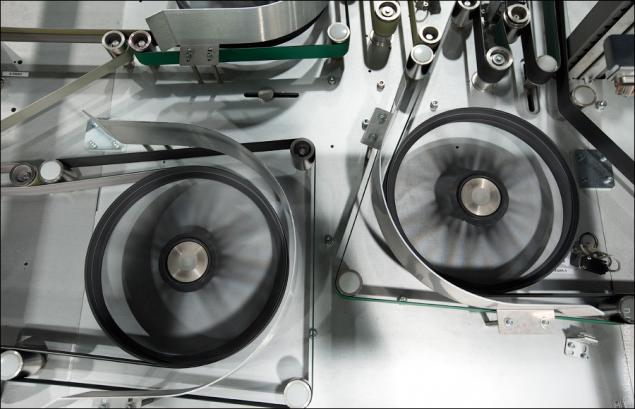
13. The equipment including software recognizes Cyrillic.

13a. If you can not recognize the code or address of the scanned image is supplied to the monitor operators who enter the information manually.

14. The letters are automatically separated by targeted cells located at the other end of the machine.
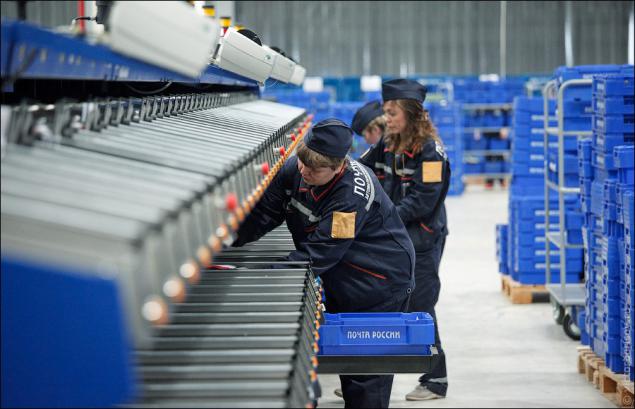
15. The recess boxes of sorted mail and transport them to the stage of preparation of documents and sending e-mail in the directions is carried out manually by operators.
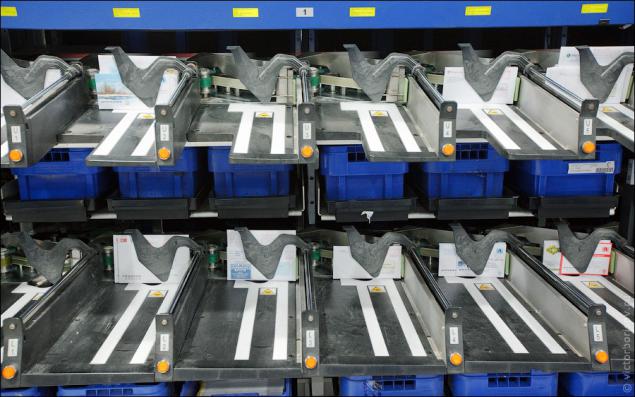
16. Nominal capacity sorters - 42,000 pieces of correspondence per hour.

17. Manual sorting of letters.
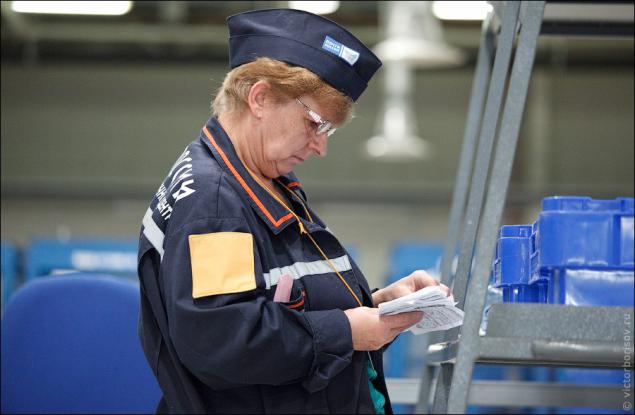
18. And the layout for targeted cells.

19. Machine for coding and sorting letters and flat format of registered mail (CFSM).
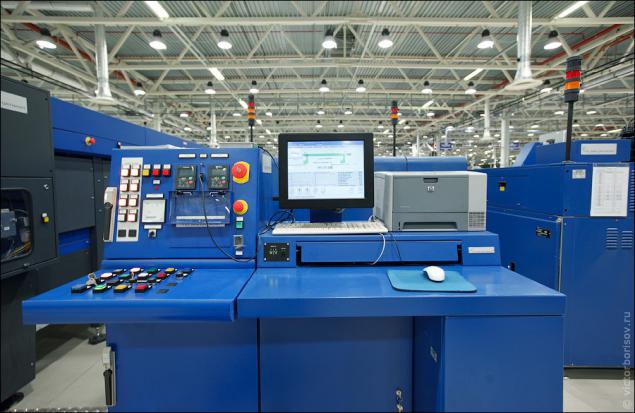
20. There is sorted written correspondence weighing up to 2, 5 kg and a thickness of no more than 25 mm.
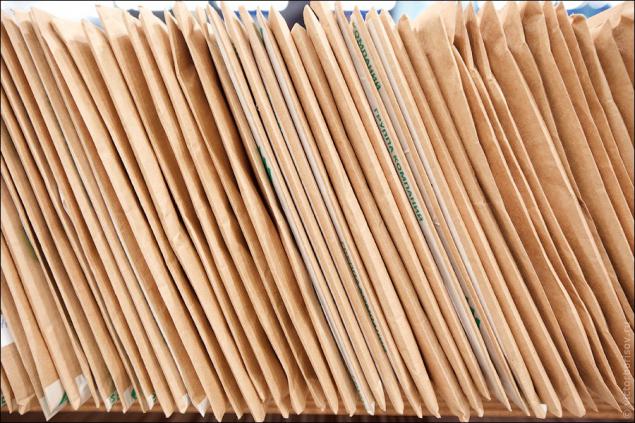
21. The sorting process is completely similar, the only difference is that the postage manually decomposed face in the same direction.

22. Workshop sorting packages and parcels (PSM).
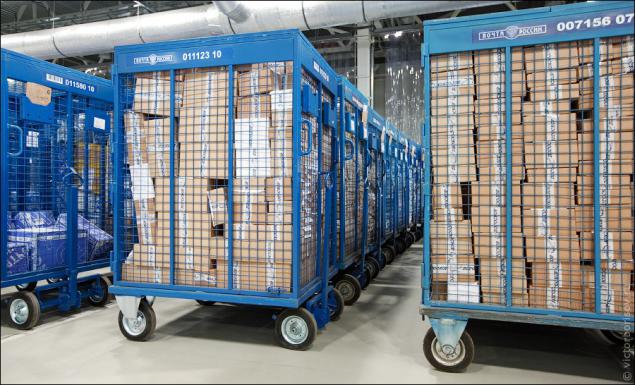
23. There are automatically sorted departure, the last of manual coding, weighing and feeding to workstations.
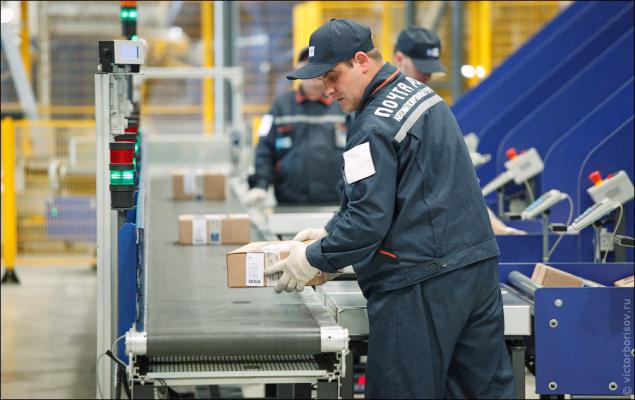
24. Parcels and packages manually stacked on the distribution pipeline.
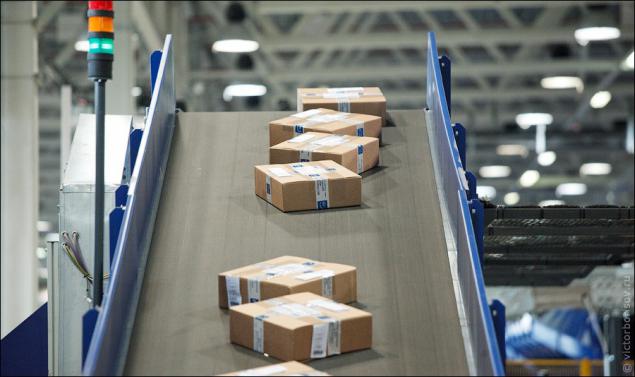
25. Where is the recognition of the encoded information and distribution of the trays according to a predetermined program.
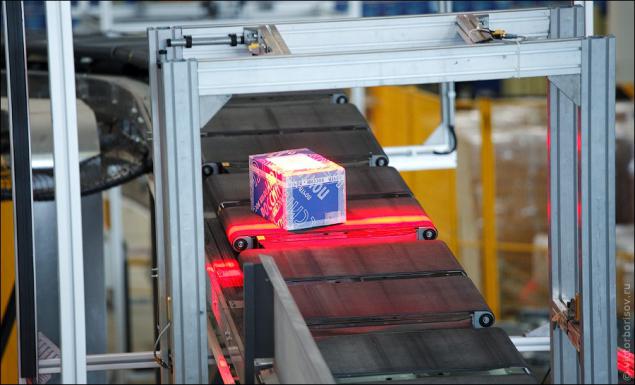
26. The system provides automatic detection of large parcels (see more 60h30h30) for shipping them in additional trays.
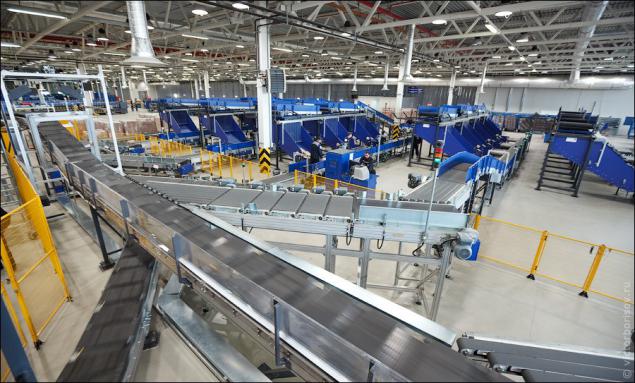
27. Recess sorted parcels and packages and transport them to the stage of preparation of documents and sending e-mail in the directions is performed manually operatoratami postal service.
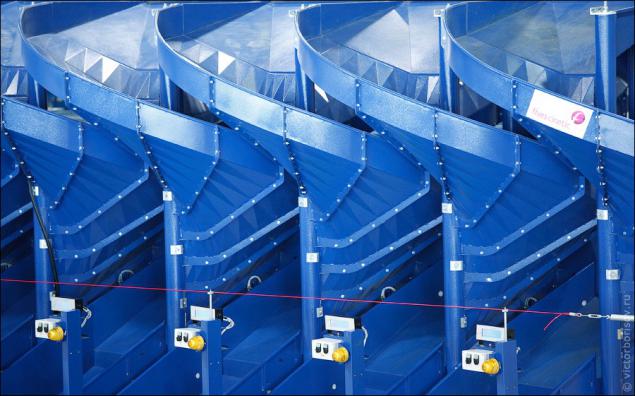
28. In total there are 5 lines to load parcels and packages and one line for large parcels. And 300 Mailbin for standard parcels. Nominal capacity - 30 thousand. Departures per hour.
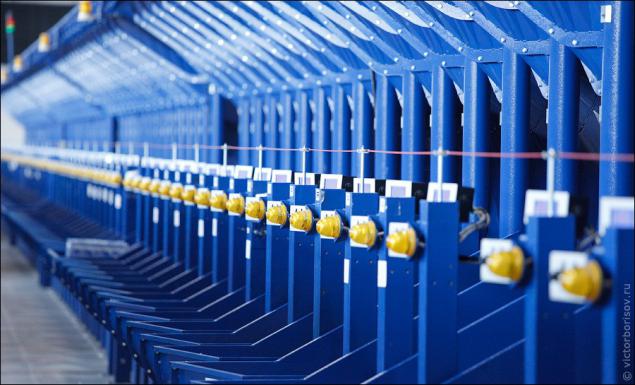
29. Part of the center is to plant hybrid mail.
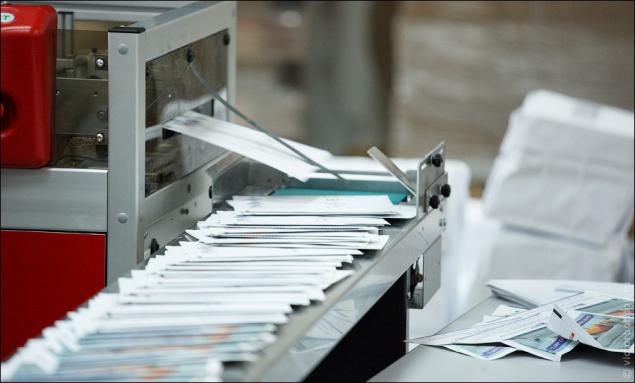
30. He receives from large corporate customers text messages in electronic form, and then prints them and sends the sender.

31. Now use the services of hybrid mail "Rostelecom", MTT, "Savings Bank" and the Pension Fund.
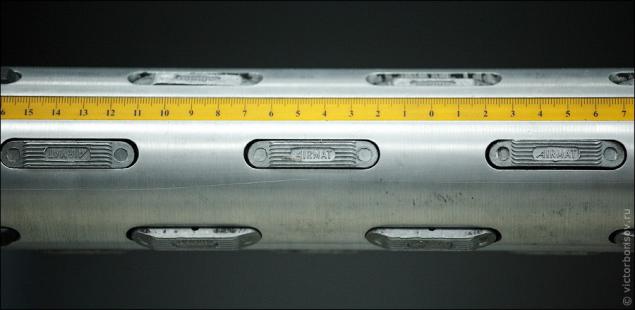
32. Following the ASC Moscow in October will start automatically sorting center in St. Petersburg, the tender for its construction was won by Siemens.

The plans to establish such centers in Yekaterinburg, Rostov-on-Don, Kazan, Novosibirsk and Mineral Waters. Total Russia requires a minimum of 20 ASC.
victorprofessor
Over the past 20 years, the system of automatic sorting using postcodes in Russia virtually absent. Prior to the opening of the Moscow ASC mailings in CFD subjected manual sorting first in the district post offices, and then - in the regional and finally, in the sorting center in Moscow. Now in regional nodes mail will only be grouped into containers and then sent to Moscow to sort ASC.
The center carries out detailed sorting (up to the post offices) to 3 million mail items per day. Through the Moscow ASC will be about 25 percent of the country's postal exchange. Switching mail traffic on Moscow ASC will reduce delivery times correspondence. Inside the Moscow-mail will be delivered per day, excluding the day of admission. For cities and regional centers this standard is 2 days for small towns and rural areas - 3 days.
1. ASC - the largest center of its kind in Eastern Europe, with an area of 29 thousand sq. M. m., and employs about 900 people. Power ASC 3 million mail items per day.

2. Correspondence within one region will first be directed to the center - as explained in the ASC, it is faster than to sort and check emails on the spot.

3. Parcel will be sorted to the area (this is due to the logistics of delivery), letters of large format (flat) - yet also to the area, but plan to purchase additional sorting machines to deliver this type of correspondence to the post office.

4. Paper correspondence falls first on litsovochno-stamping machines (CFC).

5. The machine for opening bags and dust extraction.

6. Then, with the help of mechanical devices are separated by analyzing standard (in size) letters and postcards from non-standard.

7. Poslee that letter automatically orients face in the same direction with the direction of the text in the address part.

8. At the end of the machine causes the letters date stamp and wavy lines to repay marks (stamping).

9. sorted by size letters are formed into containers and sent to the machine coding and sorting of letters (LCSM)

10. There are sorted standard letter size plain 220h110 114h162 mm mm.

11. At the beginning of the coding machine converts alphanumeric address in conditional code that is printed on the letter.

12. Next, the coded information about the postal address of scanning devices for optical character reader.

13. The equipment including software recognizes Cyrillic.

13a. If you can not recognize the code or address of the scanned image is supplied to the monitor operators who enter the information manually.

14. The letters are automatically separated by targeted cells located at the other end of the machine.

15. The recess boxes of sorted mail and transport them to the stage of preparation of documents and sending e-mail in the directions is carried out manually by operators.

16. Nominal capacity sorters - 42,000 pieces of correspondence per hour.

17. Manual sorting of letters.

18. And the layout for targeted cells.

19. Machine for coding and sorting letters and flat format of registered mail (CFSM).

20. There is sorted written correspondence weighing up to 2, 5 kg and a thickness of no more than 25 mm.

21. The sorting process is completely similar, the only difference is that the postage manually decomposed face in the same direction.

22. Workshop sorting packages and parcels (PSM).

23. There are automatically sorted departure, the last of manual coding, weighing and feeding to workstations.

24. Parcels and packages manually stacked on the distribution pipeline.

25. Where is the recognition of the encoded information and distribution of the trays according to a predetermined program.

26. The system provides automatic detection of large parcels (see more 60h30h30) for shipping them in additional trays.

27. Recess sorted parcels and packages and transport them to the stage of preparation of documents and sending e-mail in the directions is performed manually operatoratami postal service.

28. In total there are 5 lines to load parcels and packages and one line for large parcels. And 300 Mailbin for standard parcels. Nominal capacity - 30 thousand. Departures per hour.

29. Part of the center is to plant hybrid mail.

30. He receives from large corporate customers text messages in electronic form, and then prints them and sends the sender.

31. Now use the services of hybrid mail "Rostelecom", MTT, "Savings Bank" and the Pension Fund.

32. Following the ASC Moscow in October will start automatically sorting center in St. Petersburg, the tender for its construction was won by Siemens.

The plans to establish such centers in Yekaterinburg, Rostov-on-Don, Kazan, Novosibirsk and Mineral Waters. Total Russia requires a minimum of 20 ASC.
victorprofessor



















